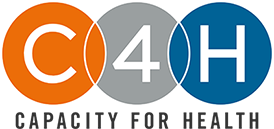At Capacity for Health, we used to take a traditional approach to problem solving. Most problem-solving frameworks are comprised of a circular model that involves the same core steps:
- Identify the problem
- Analyze the problem
- Create a plan of action
- Implement that plan
- Evaluate the results
Just type in Problem Solving Model into Google image search and you’ll see what we’re talking about. What has been fun for the C4H team is combing through endless resources to find interesting methods of “how” to do each core step. How do you identify the problem? How do you analyze it? How do you create an action plan? And the more we combed through the how’s, the more we came across a buzzword that was getting thrown around more and more: Design Thinking.
But what is Design Thinking or Human-Centered Design? Well, think of it as a method for solving complex problems in way that focuses on the people who are the most affected by the issue you’re trying to solve for. It’s an approach that many creators/makers/designers in tech have been using to develop products for their clients. Fast Company has a brief article that provides a great summary on the basics.
The more our team learned about the principles of design thinking, the more we used it to innovate the services we provide—whether it was helping a health department design a HIV testing website or creating a new company culture for a nonprofit organization. There are already many professionals across sectors who have applied a design thinking mindset into their businesses. In fact, Harvard Business Review provided a discussion on how design thinking is leading many organizations to shift the way people work. The Stanford Social Innovation Review has also written about this.
So, here’s a fun reading list to warm you up to the topic of Design Thinking, and how those in the public health sector have experimented with its application.
1. Dr. Amy Schwartz provides a nice overview of Design Thinking’s relevance to Public Health for the School of Public Health at Northwestern University.
2. Jesper Christiansen provides GOVLAB at the Tandon School of Engineering at New York University insights into how Human Centered Design can be utilized to transform policy development and public service systems.
3. Our partners at JSI, Inc. provide an overview of how Human Centered Design can be used to face public health issues.




